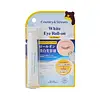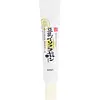What's inside
What's inside
 Key Ingredients
Key Ingredients

 Benefits
Benefits

 Concerns
Concerns

 Ingredients Side-by-side
Ingredients Side-by-side

Ascorbyl Glucoside
AntioxidantGlycyrrhetinic Acid
Skin ConditioningWater
Skin ConditioningGlycerin
HumectantDipropylene Glycol
HumectantPEG-8
HumectantDiglycerin
HumectantPentylene Glycol
Skin ConditioningRose Extract
Skin ConditioningSecale Cereale Seed Extract
AbrasiveGlycine Soja Extract
Skin ConditioningCitrus Tangerina Extract
TonicSalvia Officinalis Extract
AntimicrobialHypericum Erectum Extract
Skin ConditioningHoney
HumectantRoyal Jelly Extract
Skin ConditioningC4-18 Alkyl Methacrylate/Methacryloyloxyethyl Phosphorylcholine Copolymer
HumectantRetinyl Palmitate
Skin ConditioningPanthenol
Skin ConditioningButylene Glycol
HumectantSorbitol
HumectantHydrogenated Phosphatidylcholine
EmulsifyingGlycerin Methyl Ether
Squalane
EmollientBis-Ethoxydiglycol Cyclohexane 1,4-Dicarboxylate
EmollientPEG-20 Sorbitan Oleate
CleansingAcrylic Acid
Xanthan Gum
EmulsifyingTocopherol
AntioxidantPotassium Hydroxide
BufferingSodium Citrate
BufferingCitric Acid
BufferingPhenoxyethanol
PreservativeParfum
MaskingAscorbyl Glucoside, Glycyrrhetinic Acid, Water, Glycerin, Dipropylene Glycol, PEG-8, Diglycerin, Pentylene Glycol, Rose Extract, Secale Cereale Seed Extract, Glycine Soja Extract, Citrus Tangerina Extract, Salvia Officinalis Extract, Hypericum Erectum Extract, Honey, Royal Jelly Extract, C4-18 Alkyl Methacrylate/Methacryloyloxyethyl Phosphorylcholine Copolymer, Retinyl Palmitate, Panthenol, Butylene Glycol, Sorbitol, Hydrogenated Phosphatidylcholine, Glycerin Methyl Ether, Squalane, Bis-Ethoxydiglycol Cyclohexane 1,4-Dicarboxylate, PEG-20 Sorbitan Oleate, Acrylic Acid, Xanthan Gum, Tocopherol, Potassium Hydroxide, Sodium Citrate, Citric Acid, Phenoxyethanol, Parfum
Water
Skin ConditioningGlycerin
HumectantButylene Glycol
HumectantSqualane
EmollientDipentaerythrityl Tetrahydroxystearate/Tetraisostearate
Skin ConditioningBehenyl Alcohol
EmollientPvp
Emulsion StabilisingPentaerythrityl Tetraethylhexanoate
EmollientPEG-150
HumectantDimethicone
EmollientPentylene Glycol
Skin ConditioningBeeswax
Emulsion StabilisingDipentaerythrityl Tri-Polyhydroxystearate
EmollientPEG-60 Glyceryl Isostearate
Macadamia Ternifolia Seed Oil
EmollientGlyceryl Stearate
EmollientTrimethylsiloxysilicate
EmollientRetinol
Skin ConditioningRetinyl Palmitate
Skin ConditioningMilk Ferment
Skin ConditioningSoy Isoflavones
Skin ConditioningGlycine Max Seed Extract
Skin ConditioningCeramide Ng
Skin ConditioningSodium Tocopheryl Phosphate
AntioxidantDipropylene Glycol
HumectantPEG-40 Hydrogenated Castor Oil
EmulsifyingPPG-4-Ceteth-20
EmulsifyingSodium Ascorbate
AntioxidantAlcohol Denat.
AntimicrobialEthylhexylglycerin
Skin ConditioningCarbomer
Emulsion StabilisingXanthan Gum
EmulsifyingZea Mays Oil
EmulsifyingTocopherol
AntioxidantCaprylic/Capric Triglyceride
MaskingPolysorbate 80
EmulsifyingInulin Lauryl Carbamate
Emulsion StabilisingLecithin
EmollientSodium Hydroxide
BufferingPhenoxyethanol
PreservativeMethylparaben
PreservativeWater, Glycerin, Butylene Glycol, Squalane, Dipentaerythrityl Tetrahydroxystearate/Tetraisostearate, Behenyl Alcohol, Pvp, Pentaerythrityl Tetraethylhexanoate, PEG-150, Dimethicone, Pentylene Glycol, Beeswax, Dipentaerythrityl Tri-Polyhydroxystearate, PEG-60 Glyceryl Isostearate, Macadamia Ternifolia Seed Oil, Glyceryl Stearate, Trimethylsiloxysilicate, Retinol, Retinyl Palmitate, Milk Ferment, Soy Isoflavones, Glycine Max Seed Extract, Ceramide Ng, Sodium Tocopheryl Phosphate, Dipropylene Glycol, PEG-40 Hydrogenated Castor Oil, PPG-4-Ceteth-20, Sodium Ascorbate, Alcohol Denat., Ethylhexylglycerin, Carbomer, Xanthan Gum, Zea Mays Oil, Tocopherol, Caprylic/Capric Triglyceride, Polysorbate 80, Inulin Lauryl Carbamate, Lecithin, Sodium Hydroxide, Phenoxyethanol, Methylparaben
 Reviews
Reviews

Alternatives
Ingredients Explained
These ingredients are found in both products.
Ingredients higher up in an ingredient list are typically present in a larger amount.
Butylene Glycol (or BG) is used within cosmetic products for a few different reasons:
Overall, Butylene Glycol is a safe and well-rounded ingredient that works well with other ingredients.
Though this ingredient works well with most skin types, some people with sensitive skin may experience a reaction such as allergic rashes, closed comedones, or itchiness.
Learn more about Butylene GlycolDipropylene Glycol is a synthetically created humectant, stabilizer, and solvent.
This ingredient helps:
Dipropylene glycol is technically an alcohol, but it belongs to the glycol family (often considered part of the ‘good’ alcohols). This means it is hydrating and gentle on skin unlike drying solvent alcohols like denatured alcohol.
As a masking agent, Dipropylene Glycol can be used to cover the smell of other ingredients. However, it does not have a scent.
Studies show Dipropylene Glycol is considered safe to use in skincare.
Learn more about Dipropylene GlycolGlycerin is already naturally found in your skin. It helps moisturize and protect your skin.
A study from 2016 found glycerin to be more effective as a humectant than AHAs and hyaluronic acid.
As a humectant, it helps the skin stay hydrated by pulling moisture to your skin. The low molecular weight of glycerin allows it to pull moisture into the deeper layers of your skin.
Hydrated skin improves your skin barrier; Your skin barrier helps protect against irritants and bacteria.
Glycerin has also been found to have antimicrobial and antiviral properties. Due to these properties, glycerin is often used in wound and burn treatments.
In cosmetics, glycerin is usually derived from plants such as soybean or palm. However, it can also be sourced from animals, such as tallow or animal fat.
This ingredient is organic, colorless, odorless, and non-toxic.
Glycerin is the name for this ingredient in American English. British English uses Glycerol/Glycerine.
Learn more about GlycerinPentylene glycol is typically used within a product to thicken it. It also adds a smooth, soft, and moisturizing feel to the product. It is naturally found in plants such as sugar beets.
The hydrophilic trait of Pentylene Glycol makes it a humectant. As a humectant, Pentylene Glycol helps draw moisture from the air to your skin. This can help keep your skin hydrated.
This property also makes Pentylene Glycol a great texture enhancer. It can also help thicken or stabilize a product.
Pentylene Glycol also acts as a mild preservative and helps to keep a product microbe-free.
Some people may experience mild eye and skin irritation from Pentylene Glycol. We always recommend speaking with a professional about using this ingredient in your routine.
Pentylene Glycol has a low molecular weight and is part of the 1,2-glycol family.
Learn more about Pentylene GlycolPhenoxyethanol is a preservative that has germicide, antimicrobial, and aromatic properties. Studies show that phenoxyethanol can prevent microbial growth. By itself, it has a scent that is similar to that of a rose.
It's often used in formulations along with Caprylyl Glycol to preserve the shelf life of products.
Retinyl palmitate is a form of retinoid. Retinoids are the superstar class of anti-aging ingredients that include tretinoin and retinol.
This particular ingredient has had a bumpy year with its rise and fall in popularity.
First, Retinyl palmitate is created from palmitic acid and retinol. It is a retinol ester and considered one of the weaker forms of retinoid.
This is because all retinoids have to be converted to Tretinoin, AKA retinoic acid. Retinyl Palmitate is pretty far down the line and has to go through multiple conversions before its effects are seen.
Due to this long and ineffective conversion line, the benefits of Retinyl Palmitate are debated.
Studies show Retinyl Palmitate to help:
Dermatologists say this ingredient is ineffective because it isn't used in high enough concentrations in cosmetics.
This ingredient used to be found in sunscreens to boost the efficacy of sunscreen filters.
The downfall of Retinyl Palmitate was due to released reports about the ingredient being correlated to sun damage and skin tumors.
While there is a study showing this ingredient to cause DNA damage when exposed to UV-A, there is no concrete proof of it being linked to skin cancer. It is safe to use when used correctly.
All retinoids increase your skin's sensitivity to the sun in the first few months of usage. Be especially careful with reapplying sunscreen when using any form of retinoid.
Currently, this ingredient is still allowed in cosmetics all over the world. In Canada, cosmetics must have a warning label stating the product to contain Retinyl Palmitate
Fun fact: This ingredient is often added to low-fat milk to increase the levels of Vitamin A.
Learn more about Retinyl PalmitateSqualane is an emollient that helps the skin hold onto moisture. It's an oily liquid that occurs naturally in certain types of fish and plant oils.
Because squalane boosts hydration in the skin, it also comes with plenty of benefits: it is an antioxidant and can help fight free radicals and skin damage. Squalane is also found to have a detoxifying effect when applied.
Squalane comes from squalene, which occurs naturally within the sebum of our skin. It is one of the oils our skin produces to keep itself hydrated. Squalane is the hydrogenated version of squalene and has a longer shelf life.
Research shows that squalane is non-irritating (even at 100% concentration).
In general, it's a fantastic ingredient. It does a great job at hydrating the skin, and it's suitable for those with sensitive skin.
The source of squalane may impact malassezia / fungal acne. This is because olive oil derived squalane can contain impurities such as fatty acids and plant waxes. Sugarcane derived squalane is recommended for anyone with malassezia concerns.
Is squalane vegan?
This depends on the source. Squalane can be derived from both plants and animals. Most squalane used in skincare comes from plants.
Please note: the source of squalane is only known if disclosed by the brand. We recommend reaching out to the brand if you have any questions about their squalane.
Read more about squalene with an "e".
Is squalane an oil?
Squalane is often called an oil, but it’s technically not; it’s a hydrocarbon, meaning it’s only made of carbon and hydrogen, unlike true oils which are triglycerides made of fatty acids and glycerol.
The term “oil-free” isn’t regulated, so companies can define it however they want. Some exclude all oils, while others just avoid mineral oil or comedogenic oils.
While some people avoid oils thinking they cause breakouts, the right kind of oil (or oil-like ingredient like squalane) can actually help balance and hydrate your skin. It’s worth testing out simple oils or squalane to see what works best for your skin.
Learn more about SqualaneTocopherol (also known as Vitamin E) is a common antioxidant used to help protect the skin from free-radicals and strengthen the skin barrier. It's also fat soluble - this means our skin is great at absorbing it.
Vitamin E also helps keep your natural skin lipids healthy. Your lipid skin barrier naturally consists of lipids, ceramides, and fatty acids. Vitamin E offers extra protection for your skin’s lipid barrier, keeping your skin healthy and nourished.
Another benefit is a bit of UV protection. Vitamin E helps reduce the damage caused by UVB rays. (It should not replace your sunscreen). Combining it with Vitamin C can decrease sunburned cells and hyperpigmentation after UV exposure.
You might have noticed Vitamin E + C often paired together. This is because it is great at stabilizing Vitamin C. Using the two together helps increase the effectiveness of both ingredients.
There are often claims that Vitamin E can reduce/prevent scarring, but these claims haven't been confirmed by scientific research.
Learn more about TocopherolWater. It's the most common cosmetic ingredient of all. You'll usually see it at the top of ingredient lists, meaning that it makes up the largest part of the product.
So why is it so popular? Water most often acts as a solvent - this means that it helps dissolve other ingredients into the formulation.
You'll also recognize water as that liquid we all need to stay alive. If you see this, drink a glass of water. Stay hydrated!
Learn more about WaterXanthan gum is used as a stabilizer and thickener within cosmetic products. It helps give products a sticky, thick feeling - preventing them from being too runny.
On the technical side of things, xanthan gum is a polysaccharide - a combination consisting of multiple sugar molecules bonded together.
Xanthan gum is a pretty common and great ingredient. It is a natural, non-toxic, non-irritating ingredient that is also commonly used in food products.
Learn more about Xanthan Gum